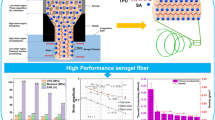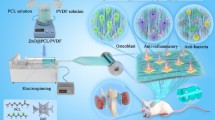Abstract
Scaffolds are three-dimensional porous structures that play an indispensable role in tissue engineering applications and can be fabricated by different techniques as tissue engineering scaffolds. In the present research work, the morphological properties and mechanical performance of polylactic acid (PLA) scaffolds fabricated by a novel combined approach of fused filament fabrication (FFF) and batch foaming were comprehensively assessed. FFF allowed us to design and precisely regulate macro-pores (external porosity) larger than 100 µm by tailoring infill percentage. The batch foaming process was utilized to create nano-pores (internal porosity) in FFF scaffolds and micro-pores in injection molded samples. The expansion ratio of injection molded and FFF solid samples was significantly improved using the batch foaming process. A pore structure in bimodal type consisting of large and small pores was formed in injection molded foamed scaffolds. The diameter of large pores was higher than 10 µm and for small pores, it was measured to be between 3 and 10 µm. These bimodal structures provided an interesting combined brittle and ductile fracture mechanism in injection molded foamed scaffolds revealed by the Charpy impact test. However, pore sizes of FFF foamed scaffolds were in the nano-meter range, presenting ductile fracture mechanism with pore-boundary fracture mode. This mechanism enhanced significantly the impact strength of FFF foamed scaffolds, up to 72% (from 118.2 to 202.8 J/m2) in FFF samples with an infill percentage of 60%.












Similar content being viewed by others
Availability of data and material
Not applicable.
Code availability
Not applicable.
References
Mabrouk M, Beherei HH, Das DB (2020) Recent progress in the fabrication techniques of 3D scaffolds for tissue engineering. Mater Sci Eng C 110:110716
Beheshtizadeh N, Lotfibakhshaiesh N, Pazhouhnia Z, Hoseinpour M, Nafari M (2020) A review of 3D bio-printing for bone and skin tissue engineering: a commercial approach. J Mater Sci 55(9):3729–3749
Pires LSO, Fernandes MHFV, de Oliveira JMM (2018) Biofabrication of glass scaffolds by 3D printing for tissue engineering. The International Journal of Advanced Manufacturing Technology 98(9):2665–2676
Kim D, Lee J, Kim G (2020) Biomimetic gelatin/HA biocomposites with effective elastic properties and 3D-structural flexibility using a 3D-printing process. Addit Manuf 36:101616
Sordi MB, Cruz A, Fredel MC, Magini R, Sharpe PT (2021) Three-dimensional bioactive hydrogel-based scaffolds for bone regeneration in implant dentistry. Mater Sci Eng C 124:112055
Zhou X, Feng Y, Zhang J, Shi Y, Wang L (2020) Recent advances in additive manufacturing technology for bone tissue engineering scaffolds. The International Journal of Advanced Manufacturing Technology 108(11):3591–3606
Zhou C, Yang K, Wang K, Pei X, Dong Z, Hong Y, Zhang X (2016) Combination of fused deposition modeling and gas foaming technique to fabricated hierarchical macro/microporous polymer scaffolds. Mater Des 109:415–424
Kantaros A, Chatzidai N, Karalekas D (2016) 3D printing-assisted design of scaffold structures. The International Journal of Advanced Manufacturing Technology 82(1–4):559–571
Yıldırım S, Demirtaş TT, Dinçer CA, Yıldız N, Karakeçili A (2018) Preparation of polycaprolactone/graphene oxide scaffolds: a green route combining supercritial CO2 technology and porogen leaching. The Journal of Supercritical Fluids 133:156–162
Alizadeh M, Abbasi F, Khoshfetrat AB, Ghaleh H (2013) Microstructure and characteristic properties of gelatin/chitosan scaffold prepared by a combined freeze-drying/leaching method. Mater Sci Eng, C 33(7):3958–3967
Zhou Y, Hu Z, Du D, Tan GZ (2019) The effects of collector geometry on the internal structure of the 3D nanofiber scaffold fabricated by divergent electrospinning. The International Journal of Advanced Manufacturing Technology 100(9):3045–3054
Molladavoodi S, Gorbet M, Medley J, Kwon HJ (2013) Investigation of microstructure, mechanical properties and cellular viability of poly (L-lactic acid) tissue engineering scaffolds prepared by different thermally induced phase separation protocols. J Mech Behav Biomed Mater 17:186–197
Liu Z, Wang Y, Wu B, Cui C, Guo Y, Yan C (2019) A critical review of fused deposition modeling 3D printing technology in manufacturing polylactic acid parts. The International Journal of Advanced Manufacturing Technology 102(9):2877–2889
Wang L, Wang D, Zhou Y, Zhang Y, Li Q, Shen C (2019) Fabrication of open-porous PCL/PLA tissue engineering scaffolds and the relationship of foaming process, morphology, and mechanical behavior. Polym Adv Technol 30(10):2539–2548
Li M, Jiang J, Hu B, Zhai W (2020) Fused deposition modeling of hierarchical porous polyetherimide assisted by an in-situ CO2 foaming technology. Combust Sci Technol 200:108454
Zhao P, Gu H, Mi H, Rao C, Fu J, Turng LS (2018) Fabrication of scaffolds in tissue engineering: a review. Front Mech Eng 13(1):107–119
Mihankhah P, Azdast T, Mohammadzadeh H, Hasanzadeh R, Aghaiee S, (2021) Fused filament fabrication of biodegradable polylactic acid reinforced by nanoclay as a potential biomedical material. J Thermoplast Compos Mater. https://doi.org/10.1177/2F08927057211044185
Zhang H, Huang T, Jiang Q, He L, Bismarck A, Hu Q (2021) Recent progress of 3D printed continuous fiber reinforced polymer composites based on fused deposition modeling: a review. J Mater Sci 1–24
Pu’ad NM, Haq RA, Noh HM, Abdullah HZ, Idris MI, Lee TC (2020) Review on the fabrication of fused deposition modelling (FDM) composite filament for biomedical applications. Materials Today: Proceedings 29:228–232
Hasanzadeh R, Azdast T, Doniavi A, Rostami M (2019) A prediction model using response surface methodology based on cell size and foam density to predict thermal conductivity of polystyrene foams. Heat Mass Transf 55(10):2845–2855
Azdast T, Lee RE, Hasanzadeh R, Moradian M, Shishavan SM (2019) Investigation of mechanical and morphological properties of acrylonitrile butadiene styrene nanocomposite foams from analytical hierarchy process point of view. Polym Bull 76(5):2579–2599
Dave HK, Rajpurohit SR, Patadiya NH, Dave SJ, Sharma KS, Thambad SS, Srinivasn VP, Sheth KV (2019) Compressive strength of PLA based scaffolds: effect of layer height, infill density and print speed. International Journal of Modern Manufacturing Technologies 11(1):21–27
Lee J, Lee H, Cheon KH, Park C, Jang TS, Kim HE, Jung HD, (2019) Fabrication of poly (lactic acid)/Ti composite scaffolds with enhanced mechanical properties and biocompatibility via fused filament fabrication (FFF)–based 3D printing. Addit Manuf 30:100883
Zhao H, Li L, Ding S, Liu C, Ai J (2018) Effect of porous structure and pore size on mechanical strength of 3D-printed comby scaffolds. Mater Lett 223:21–24
Khodaei M, Amini K, Valanezhad A, (2020) Fabrication and characterization of poly lactic acid scaffolds by fused deposition modeling for bone tissue engineering. Journal of Wuhan University of Technology-Mater. Sci. Ed., 35(1):248–251
Hamandi FMRA (2020) Hierarchical structure, properties and bone mechanics at macro, micro, and nano levels, Ph.D. Thesis, Wright State University
Lee S, Porter M, Wasko S, Lau G, Chen PY, Novitskaya EE, Tomsia AP, Almutairi A, Meyers MA, McKittrick J (2012) Potential bone replacement materials prepared by two methods. MRS Online Proceedings Library (OPL) 1418:177–188
Cooper DML, Kawalilak CE, Harrison K, Johnston BD, Johnston JD (2016) Cortical bone porosity: what is it, why is it important, and how can we detect it? Curr Osteoporos Rep 14(5):187–198
Jie W, Dongqin X, Jinyu L, Wei Z, Yandong M (2016) Modulation of macro-, micro-and nano-structures of porous bioceramic scaffolds for regenerative bone tissue. Front Bioeng Biotechnol 4. https://doi.org/10.3389/conf.fbioe.2016.01.01261
Song P, Zhou C, Fan H, Zhang B, Pei X, Fan Y, Jiang Q, Bao R, Yang Q, Dong Z, Zhang X (2018) Novel 3D porous biocomposite scaffolds fabricated by fused deposition modeling and gas foaming combined technology. Compos B Eng 152:151–159
Azdast T, Hasanzadeh R (2021) Polylactide scaffold fabrication using a novel combination technique of fused deposition modeling and batch foaming: dimensional accuracy and structural properties. The International Journal of Advanced Manufacturing Technology 114(5):1309–1321
Hasanzadeh R, Azdast T, Doniavi A, Lee RE (2019) Thermal conductivity of low density polyethylene foams part I: comprehensive study of theoretical models. J Therm Sci 28(4):745–754
Mastikhina O, Moon BU, Williams K, Hatkar R, Gustafson D, Mourad O, Sun X, Koo M, Lam AY, Sun Y, Fish JE (2020) Human cardiac fibrosis-on-a-chip model recapitulates disease hallmarks and can serve as a platform for drug testing. Biomaterials 233:119741
Lee RE, Azdast T, Wang G, Wang X, Lee PC, Park CB (2020) Highly expanded fine-cell foam of polylactide/polyhydroxyalkanoate/nano-fibrillated polytetrafluoroethylene composites blown with mold-opening injection molding. Int J Biol Macromol 155:286–292
Zhao J, Wang G, Wang C, Park CB (2020) Ultra-lightweight, super thermal-insulation and strong PP/CNT microcellular foams. Combust Sci Technol 191:108084
Azdast T, Hasanzadeh R (2021) Increasing cell density/decreasing cell size to produce microcellular and nanocellular thermoplastic foams: a review. J Cell Plast 57(5):769–797
Hasanzadeh R, Azdast T, Doniavi A, Lee RE (2019) Multi-objective optimization of heat transfer mechanisms of microcellular polymeric foams from thermal-insulation point of view. Thermal Science and Engineering Progress 9:21–29
Hasanzadeh R, Azdast T, Doniavi A (2020) Thermal conductivity of low-density polyethylene foams part II: deep investigation using response surface methodology. J Therm Sci 29(1):159–168
Bao JB, Junior AN, Weng GS, Wang J, Fang YW, Hu GH (2016) Tensile and impact properties of microcellular isotactic polypropylene (PP) foams obtained by supercritical carbon dioxide. The Journal of Supercritical Fluids 111:63–73
Mills NJ, Kang P (1994) The effect of water immersion on the mechanical properties of polystyrene bead foam used in soft shell cycle helmets. J Cell Plast 30(3):196–222
Author information
Authors and Affiliations
Contributions
Mr. Asghar Rasouli: methodology, software, formal analysis, writing—original draft. Prof. Taher Azdast: conceptualization, methodology, validation, investigation, writing—review and editing, supervision. Dr. Hurieh Mohammadzadeh: writing—review and editing. Mr. Peyman Mihankhah: methodology, software, formal analysis, writing—original draft. Dr. Rezgar Hasanzadeh: conceptualization, methodology, validation, investigation, writing—review and editing.
Corresponding author
Ethics declarations
Ethics approval
This manuscript is not a life science study and does not report the results of studies involving humans and/or animals.
Consent to participate
This manuscript is not a life science study and does not report the results of studies involving humans and/or animals.
Consent for publication
This manuscript is not a life science study and does not report the results of studies involving humans and/or animals.
Conflict of interest
The authors declare no competing interests.
Additional information
Publisher's Note
Springer Nature remains neutral with regard to jurisdictional claims in published maps and institutional affiliations.
Rights and permissions
About this article
Cite this article
Rasouli, A., Azdast, T., Mohammadzadeh, H. et al. Morphological properties and mechanical performance of polylactic acid scaffolds fabricated by a novel fused filament fabrication/gas foaming coupled method. Int J Adv Manuf Technol 119, 7463–7474 (2022). https://doi.org/10.1007/s00170-022-08743-x
Received:
Accepted:
Published:
Issue Date:
DOI: https://doi.org/10.1007/s00170-022-08743-x




